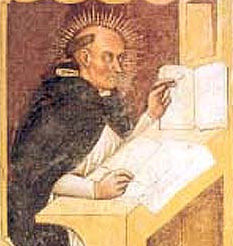| Profile | Major Works | Resources |
Raymond of Peņafort, 1180-1275.

Catalan Scholastic, compiler of the second major collection of canon law (Ecclesiastical law), after Gratian.
Raymond of Peņafort was a native of Catalonia, and studied and taught at Barcelona, before moving to Bologna to study. He taught canon law at Bologna for many years During this time he wrote his Summa luris Canonici, a handbook of canon law (not a compilation). He returned to Catalonia in 1222 and became a canon of Barcelona cathedral and joined the Dominican order of preachers at an unusually late age (he was in his forties). At the request of the Dominicans, he wrote an extensive Summa on the sacraments of penance and marriage.
In 1230, Raymond of Peņafort was summoned to Rome by Pope Gregory IX to serve as his chaplain. He was subsequently commissioned by the Pope to compile of a new collection of the eighty years of papal laws and decretals that hd been issued after Gratian's 1140 Decretum. The result of Peņafort labors was the Nova Compilatio decretalium, also known as the "Five Books of the Decretals" or the Liber Extra (extra meaning outside of Gratian), or the Decretales Gregorii IX. (as a matter of customary usage, it is common to reserve the term "Decretum" for Gratian and "Decretals" for Peņafort's collection)
Raymond of Peņafort scoured and sifted the existing collections of post-Gratian decretals, most notably the five books known as the Quinque compilationes antiquae ("Five Old Compilations"). These were:
- (1) the 1191 Breviarum extravagantium of Bernard of Pavia, which contained the papal decretals missed by Gratian (1140), up to the papacy of Clement III (1187-91), inclusive (known as the Prima of the post-Gratian compilations).
- (2) the 1210 Compilatio Tercia of Cardinal Petrus Collivacinus of Benevento, which contained the papal decretals of the first part of the papacy of Innocent III (1198-1210).
- (3) the 1216 Decretales mediae of John of Wales, containing the papal decretals of Clement III and Celestine III (1191-1198). (Note:although written after the the 1210 "Tercia" compilation, its decretals chronologically precede it, so it is commonly called the "Secunda" of the post-Gratian books).
- (4) the 1216 Compilatio Quarta, possibly by Johannes Teutonicus of Bologna, completing the decretals of Innocent III and the canons of the Fourth Lateran Council of 1215.
- (5) the 1227 Compilatio Quinta by an unknown author, compiling the decretals of Honorius III (1216-1227).
(Only two of the five (Tercia 1210 and Quinta, 1227) had been declared official by papal bull and given force of law.)
Of the resulting 1971 chapters of Raymond de Peņafort's Nova Compilatio decretalium, 1771 chapters were drawn from these five old compilations, the Quinque, 191 chapters were new decretals from the papacy of Gregory IX, and the remaining 9 are a handful that were forgotten earlier. 383 Quinque decisions were omitted, as overlapping or superseded.
In his bull Rex pacificus of 5 September, 1234, Pope Gregory IX declared that Peņafort's Nova Compilatio to be the official code of the canon law, all its decisions as written there, whether authentic or not, whether accurately reproduced from the original text or not, have the force of law. It also abrogates all the Quinque collections, even the official ones. However, it does not abrogate Gratian 's Decretum (but also does not make that official either).
Gratian's Decretum and the Peņafort Nova Compliatio were the only two texts of canon law used for a while, until the addition of the Liber Sextus of Pope Boniface XIII in 1298 and the Clementine Constitutions of Pope Clement V (1317). These four books, taken together, constituted the Corpus Juris Canonici (Canon Law) during the Middle Ages.
(Two more collections, the Viginti Extravagantes Joannis XXII (1325) and the Extravagantes communes compiled by Jean Chappuis in 1505, are sometimes added to this list, although they were never given official status.).
Shortly after completing his collection, Raymond of Peņafort was offered the Archbishopric of Tarragona by the pope, but he turned down the offer. He returned to Barcelona as a mere friar. In 1238, he was elected Master-General of the Dominican Order and served for two years, during which he revised the constitutions and regulations of the order. After he resigned, he set about trying to launch proselytizing missions among Muslims and Jews for much of the remainder of his life.
Raymond of Peņafort was canonized as a saint of the Roman
Catholic Church.
|
Major Works of Raymond of Peņafort
|
|
Resources on Raymond of Peņafort
|
All rights reserved, Gonįalo L. Fonseca
